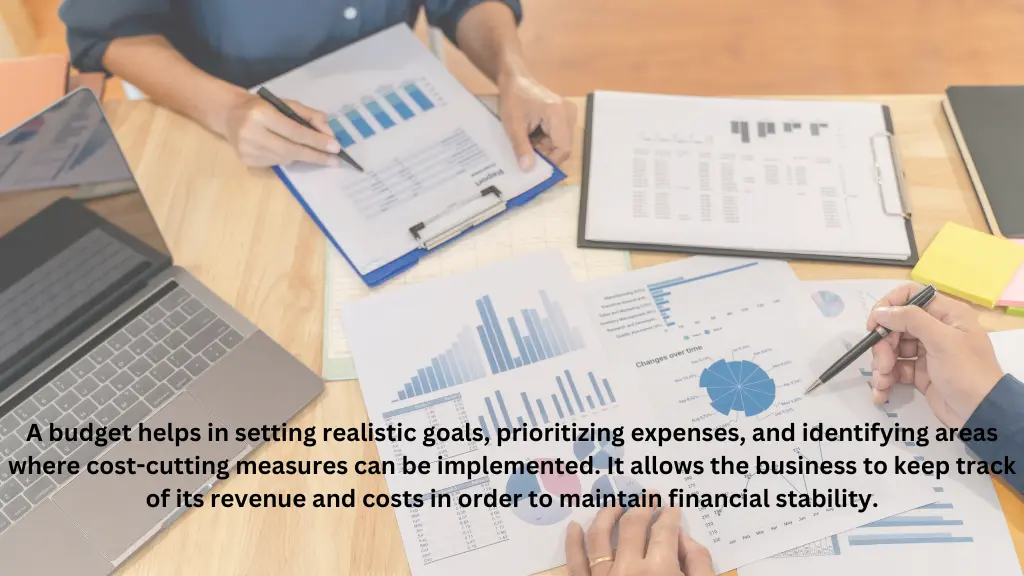A budget is a formal financial plan that outlines expected income and expenses for a specific period. It is a crucial tool for managing finances effectively for both individuals and businesses.

A budget helps in setting realistic goals, prioritizing expenses, and identifying areas where cost-cutting measures can be implemented. Yes, it allows the business to keep track of its revenue and costs in order to maintain financial stability.
In this article, we will explore the importance of budgeting, different types of budgets, and strategies for creating and sticking to a budget that aligns with your financial objectives.
Purpose of a Budget
A budget is more than just a collection of numbers; it’s a strategic tool that serves several crucial purposes for a business:
1. Financial Planning and Control: A budget acts as a blueprint, outlining the anticipated revenue and expenses for a specific period. This proactive approach enables businesses to allocate resources effectively, set realistic goals, and make data-driven decisions.
2. Resource Allocation: Every business has limited resources, whether it’s capital, labor, or raw materials. A well-designed budget helps prioritize and allocate these resources efficiently, ensuring they are directed toward the areas that drive growth and profitability.
3. Performance Evaluation: By comparing actual results to the budgeted figures, businesses can identify areas of strength and weakness, pinpoint opportunities for improvement, and make necessary adjustments to stay on track.
Types of Budgets
Just as there are different types of businesses, there are various budgets tailored to meet specific needs. Here are some common types:
Operating Budget
The operating budget is the backbone of a business’s financial plan. It encompasses three main components:
1. Sales Budget: This budget forecasts the anticipated revenue from sales of goods or services, taking into account factors such as market demand, pricing strategies, and sales projections.
2. Production Budget: For businesses involved in manufacturing or production, this budget outlines the necessary resources, including raw materials, labor, and overhead costs, to meet the sales targets.
3. Expenses Budget: This budget covers all the operational expenses a business incurs, such as rent, utilities, salaries, marketing, and administrative costs.
Financial Budget
The financial budget focuses on the company’s overall financial position and includes:
1. Cash Flow Budget: This budget projects the anticipated cash inflows and outflows, ensuring that the business has sufficient liquidity to meet its financial obligations.
2. Capital Expenditure Budget: This budget outlines the planned investments in long-term assets, such as equipment, facilities, or technology, to support the company’s growth and operations.
Steps in Creating a Budget
Crafting an adequate budget is a collaborative process that involves several key steps:
1. Determining Financial Goals: Before analyzing the numbers, it’s crucial to establish clear financial goals for the business. These goals should align with the company’s overall strategy and vision.
2. Gathering Relevant Data: Accurate budgeting requires a solid foundation of data. This includes historical financial data, market trends, industry benchmarks, and any other relevant information that can inform realistic projections.
3. Forecasting Revenue and Expenses: Using the gathered data, businesses can forecast future revenue streams and anticipated expenses. This step involves analyzing factors such as market demand, pricing strategies, cost of materials, labor costs, and overhead expenses.
4. Allocating Resources: Once the revenue and expense projections are in place, businesses can allocate resources strategically, ensuring that funds are directed toward the most critical areas for growth and profitability.
5. Monitoring and Adjusting: A budget is not a static document; it’s a living, breathing plan that requires regular monitoring and adjustment. By comparing actual results to budgeted figures, businesses can identify variances and make necessary adjustments to keep their financial goals on track.
Benefits of Budgeting

Implementing a robust budgeting process can yield numerous benefits for a business:
1. Financial Stability: By carefully tracking revenue and expenses, businesses can maintain a stable financial footing, mitigating the risk of cash flow issues or economic distress.
2. Cost Control: A well-designed budget helps businesses identify areas of overspending and implement cost-cutting measures where necessary, enhancing overall profitability.
3. Informed Decision-Making: With accurate financial data at their fingertips, business owners and managers can make informed decisions regarding investments, expenditures, and strategic initiatives.
4. Accountability and Transparency: A budget promotes transparency within the organization, holding departments and individuals accountable for their financial performance and resource utilization.
Challenges in Budgeting
While budgeting is a powerful tool, it’s not without its challenges. Some common hurdles businesses face include:
1. Accurate Forecasting: Predicting future revenue and expenses can be challenging, especially in volatile or rapidly changing markets. External factors, such as economic conditions, competition, and consumer behavior, can impact projections.
2. Flexibility and Adaptability: Businesses operate in dynamic environments, and unexpected events or opportunities may arise, requiring adjustments to the budget. Striking a balance between adhering to the budget and remaining adaptable is essential.
3. Commitment and Buy-In: Effective budgeting requires commitment and buy-in from all stakeholders within the organization.
Lack of engagement or resistance to change can hinder the successful implementation of a budgeting process.
Best Practices for Effective Budgeting
To maximize the benefits of budgeting and overcome potential challenges, businesses should adopt the following best practices:
1. Involve Stakeholders: Encourage input and collaboration from various departments and team members during the budgeting process. This fosters a sense of ownership and increases the likelihood of adherence to the budget.
2. Use Appropriate Tools and Software: Leverage budgeting software or spreadsheet tools to streamline the process, improve accuracy, and enable real-time tracking and reporting.
3. Review and Update Regularly: Budgets should be reviewed and updated regularly, typically on a monthly or quarterly basis, to reflect changing circumstances and ensure relevance.
4. Align with Business Strategy: The budget should be closely tied to the overall business strategy, ensuring that resources are allocated in a manner that supports the company’s long-term goals and objectives.
Conclusion
In the dynamic world of business, a well-crafted budget is more than just a collection of numbers; it’s a powerful tool that empowers companies to navigate the financial landscape with confidence.
By carefully tracking revenue and expenses, businesses can maintain economic stability, make informed decisions, and allocate resources effectively.
Embrace the power of a formal budget, and watch as your business soars to new heights of financial success.
Remember, a budget is not a constraint but a compass, guiding you toward your desired destination and ensuring you stay on course, no matter the challenges that may arise.
Master the art of budgeting to unlock your business’s full potential and embark on a journey toward sustained growth, profitability, and financial stability.
[su_button Id= download url=”https://selffinance.info/how-should-students-pay-for-monthly-expenses/” target=”blank” size=”10″]CLICK HERE[/su_button]





